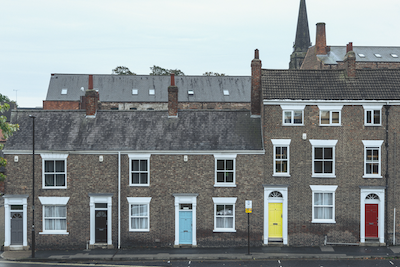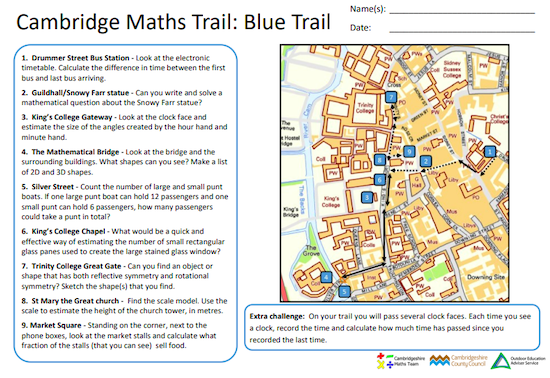Or search by topic
Number and algebra
Geometry and measure
Probability and statistics
Working mathematically
Advanced mathematics
For younger learners
Maths Trails - Encouraging Purposeful Outdoor Learning
The original version of this article appeared in Horizons, a magazine to support professional development in outdoor learning, published by the Institute for Outdoor Learning.
In this article, Becky Moseley describes how the Cambridgeshire Primary Maths Team and Outdoor Education Advisor teamed up to create eleven maths trails based on locations around Cambridgeshire and Peterborough. She outlines their aims and experiences in the hope that they might inspire others to consider exploring outdoor maths opportunities in similar ways.
As maths advisers, having taught and led maths in a range of primary schools around the country, we were all aware of the many potential benefits of taking learning outside. We were also aware, however, of some of the reasons that many teachers do not use the outdoor environment more often. In creating the maths trails, it was our hope that we would encourage initially reluctant teachers to take that first step towards outdoor maths learning.
When we embarked on this project, we had the following aims:
- To increase motivation and engagement with maths learning.
- To support pupils in linking maths to real-life and understanding its usefulness.
- To encourage schools to engage with their local areas.
- To encourage high quality maths talk, collaboration and problem-solving skills.
- To inspire teachers to provide pupils with more opportunities to learn outdoors and to be more active.
Initially, we met to discuss possible formats for the maths trails. We decided that each maths trail should take around one to two hours to complete, making it possible for teachers to combine a maths trail with a half-day visit to a nearby place of interest. We agreed that the maths trail activities should relate to the maths content in the current National Curriculum for 7-to-11-year-olds, allowing pupils to apply previously taught concepts and skills and support them in making links between them. This was important as one of the reasons some teachers do not engage with outdoor learning relates to the demands of the curriculum and timetabling concerns. We agreed that teachers would be more likely to try a maths trail if it tied in with content they were already expected to teach rather than unrelated concepts. In addition, we reasoned that linking activities to taught concepts would support children in understanding their usefulness and engaging with mathematics in their environments more widely.
 We also decided that wherever possible, questions should require pupils to be in the specific location indicated by the maths trail in order to answer them. This ensured that there was a reason to be outside rather than in the classroom. We also aimed to include tasks which
required problem-solving, reasoning and fluency, and as many different mathematical domains as possible. At this point a format for the maths trails was created and ten locations around Cambridgeshire and Peterborough were chosen as being potentially suitable for maths trails.
We also decided that wherever possible, questions should require pupils to be in the specific location indicated by the maths trail in order to answer them. This ensured that there was a reason to be outside rather than in the classroom. We also aimed to include tasks which
required problem-solving, reasoning and fluency, and as many different mathematical domains as possible. At this point a format for the maths trails was created and ten locations around Cambridgeshire and Peterborough were chosen as being potentially suitable for maths trails.
With agreed parameters in mind, we set off (in all weathers!) to explore and find the maths in each location. Because we wanted the maths trails to be suitable for both small groups and whole classes, we were careful to ensure that each point on the trails provided space for children to stand and work safely. For this reason, some possible activities and questions were not included in the finished trails.
In addition, we were careful not to include questions too closely based on features which were likely to change over time, such as timetables and calendars of events. An example of this is a question set at the Drummer Street Bus Station in Cambridge. Rather than asking a question specific to the current timetable, we created a question which could be applied to any future timetable:
Look at the electronic timetable. Calculate the difference in time between the first bus and last bus arriving.
Another example of this can be found on our St Neots Maths Trail at the museum:
If a group of tourists consisting of 25 adults, 5 seniors and 10 children visited the museum, how much would they pay in total for their admission tickets?
In this case, the question can still be used if the museum changes their admission charges in the future.
To ensure consistency, each of our maths trails is made up of the same components: a route map, instructions for adults, and question and answer sheets for children.
In order to maintain children’s interest between activities, each trail contains an extra challenge which needs to be completed between the start and finish of the route. This is an example from the Peterborough trail:
On your trail you will find or pass several plaques. Each plaque records a year in which a historic event happened. Record each year that you see and then write them in chronological order from oldest to most recent event.
 When we formulated the maths trails, we also aimed to include cross-curricular links to other subjects and opportunities to practise skills which could be transferred to other situations. Some of our trails, for example, provide opportunities for data collection (e.g. traffic
surveys) or estimation (e.g. of height, length, circumference and number of windows on a building).
When we formulated the maths trails, we also aimed to include cross-curricular links to other subjects and opportunities to practise skills which could be transferred to other situations. Some of our trails, for example, provide opportunities for data collection (e.g. traffic
surveys) or estimation (e.g. of height, length, circumference and number of windows on a building).
Others encourage the application of knowledge learnt during science topics. For example, one of the tasks included
in the St Ives trail asks children to predict which trees would cast the largest shadows at midday and at 3pm, and then asks them how they would check their predictions.
Although the maths trails can all be used as they are, it is our hope that teachers will adapt them as necessary, for example, for younger or older children. Furthermore, if it is not possible for groups to travel to one of our maths trail locations, we hope that our activity ideas will inspire them to write their own trails for their local town, city, village, or even school grounds. Having completed a maths trail, teachers might also like to ask their pupils to write their own maths trails for other children to use.
Thinking of organising a Maths Trail?
Here are the team's top tips:
- Decide on a convenient start and end point for your maths trail. This is especially important if you are travelling to a location away from school.
- Keep safety in mind. Are there safe places for children to stand and participate in each activity? Have you carried out a risk assessment to include safe movement around the trail?
- Ensure that there is a point to being outside. Could your questions be answered back in the classroom or do the children need to be in a specific location?
- Check that the tasks you have planned do not have a 'use by date'. Is anything in the environment likely to change and make a question unanswerable?
- If your trail involves walking some distance between each activity point, give children a challenge they can complete during the trail as a whole.
- Try to ensure that activities are varied and do not all rely on counting features or objects.
- Have a go! If you are unable to take children to the nearest town, city or outdoor centre, organise a maths trail to be completed in the school grounds or immediate area.
The Cambridgeshire and Peterborough maths trails are free and available to all who would like to use them. Although they were written with teachers and schoolchildren in mind, they might also be of interest to leaders of youth groups and families who live near to or are visiting one of the locations covered by a trail.

